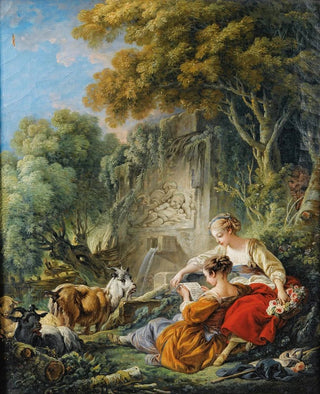Art print | Read the letter - François Boucher


View from behind

Frame (optional)
In the refined world of 18th-century French art, the art print "Lire la lettre" by François Boucher stands out as a true gem. Capturing a moment of intimate life, this delicate scene evokes the sweetness of human relationships and the escape that reading can offer. The composition, imbued with sensuality and lightness, transports the viewer into a universe where time seems suspended. Through the delicate gestures of the protagonists, Boucher manages to create an atmosphere filled with tenderness and curiosity, inviting everyone to share this fleeting moment. The art print Lire la lettre - François Boucher allows appreciation of the magic of this work, while making it accessible to those wishing to enrich their living space with a touch of elegance.
Style and uniqueness of the work
François Boucher's style is characterized by a rococo approach, marked by shimmering colors and voluptuous forms. In "Lire la lettre," the pastel color palette and the play of light accentuate the softness of faces and fabrics, creating a captivating visual harmony. The composition, skillfully orchestrated, highlights the interaction between the characters, where each gesture and gaze tell a story. The posture of the woman, leaning over a letter, evokes the intimacy of a shared moment, while the man, in the background, appears both attentive and admiring. This work is a perfect example of Boucher's ability to combine pictorial technique and emotion, transforming an ordinary scene into a poetic representation of everyday life.
The artist and his influence
François Boucher, born in 1703, is one of the most emblematic painters of 18th-century France. A student of François Le Moyne, he quickly distinguished himself by his talent and originality. His career, marked by his role as court painter, allowed him to mingle with the aristocracy and absorb the refined tastes of his time. Boucher is also known for his numerous mythological and pastoral works, but it is in the depiction of intimate life and genre scenes that he truly excels. His influence is felt well beyond his era, inspiring generations

Matte finish

View from behind

Frame (optional)
In the refined world of 18th-century French art, the art print "Lire la lettre" by François Boucher stands out as a true gem. Capturing a moment of intimate life, this delicate scene evokes the sweetness of human relationships and the escape that reading can offer. The composition, imbued with sensuality and lightness, transports the viewer into a universe where time seems suspended. Through the delicate gestures of the protagonists, Boucher manages to create an atmosphere filled with tenderness and curiosity, inviting everyone to share this fleeting moment. The art print Lire la lettre - François Boucher allows appreciation of the magic of this work, while making it accessible to those wishing to enrich their living space with a touch of elegance.
Style and uniqueness of the work
François Boucher's style is characterized by a rococo approach, marked by shimmering colors and voluptuous forms. In "Lire la lettre," the pastel color palette and the play of light accentuate the softness of faces and fabrics, creating a captivating visual harmony. The composition, skillfully orchestrated, highlights the interaction between the characters, where each gesture and gaze tell a story. The posture of the woman, leaning over a letter, evokes the intimacy of a shared moment, while the man, in the background, appears both attentive and admiring. This work is a perfect example of Boucher's ability to combine pictorial technique and emotion, transforming an ordinary scene into a poetic representation of everyday life.
The artist and his influence
François Boucher, born in 1703, is one of the most emblematic painters of 18th-century France. A student of François Le Moyne, he quickly distinguished himself by his talent and originality. His career, marked by his role as court painter, allowed him to mingle with the aristocracy and absorb the refined tastes of his time. Boucher is also known for his numerous mythological and pastoral works, but it is in the depiction of intimate life and genre scenes that he truly excels. His influence is felt well beyond his era, inspiring generations






